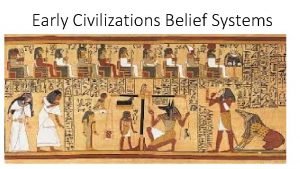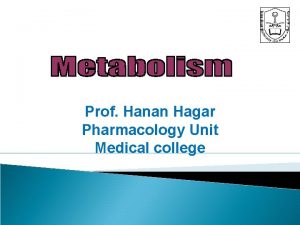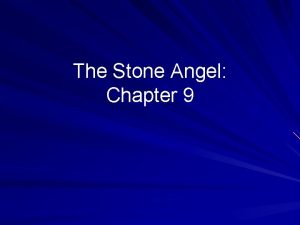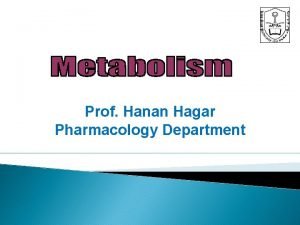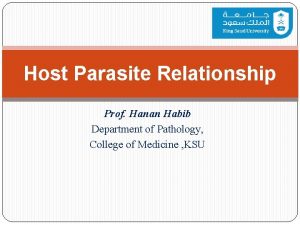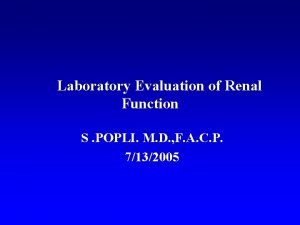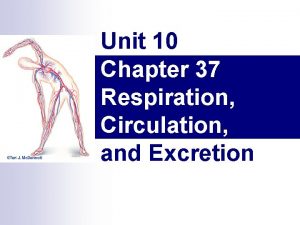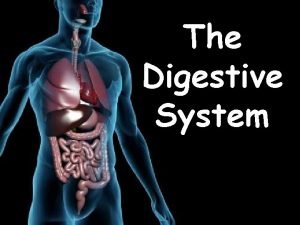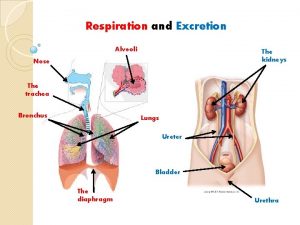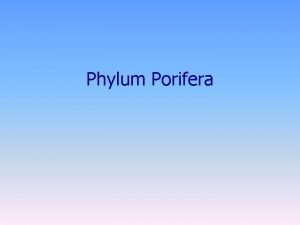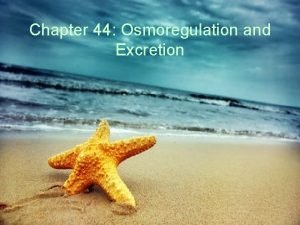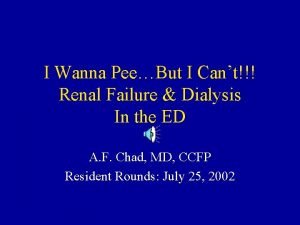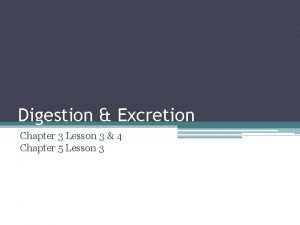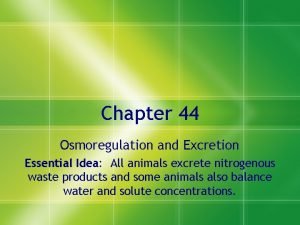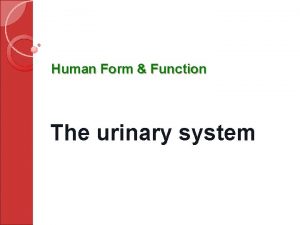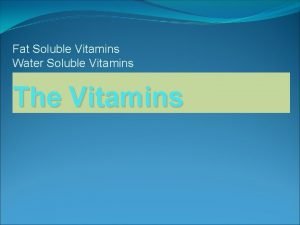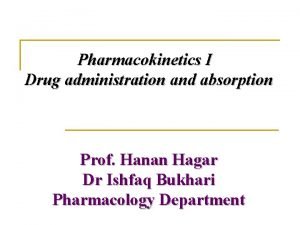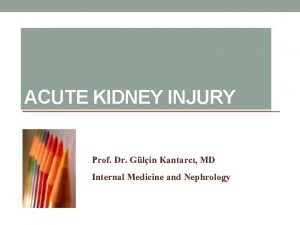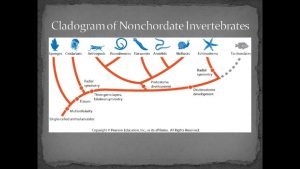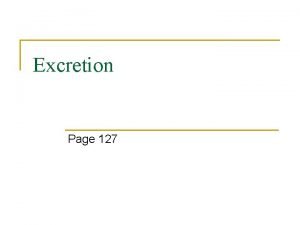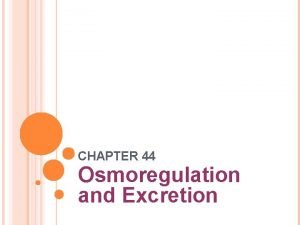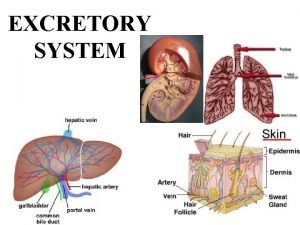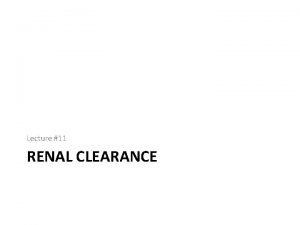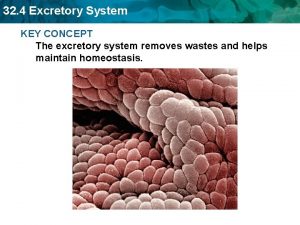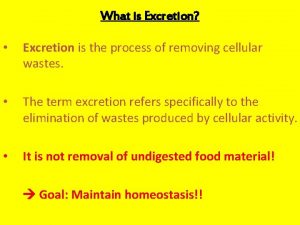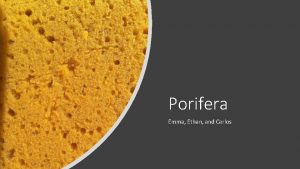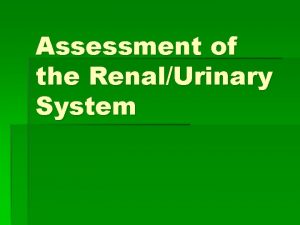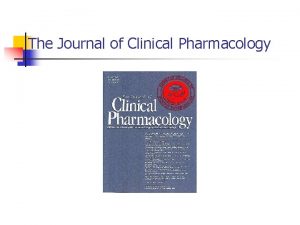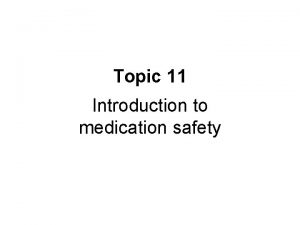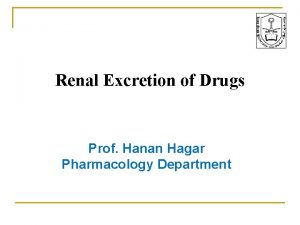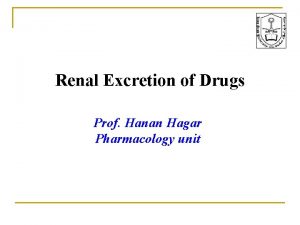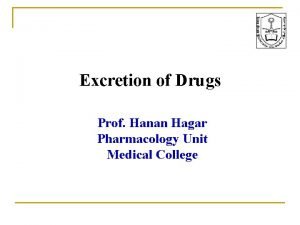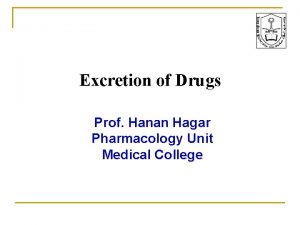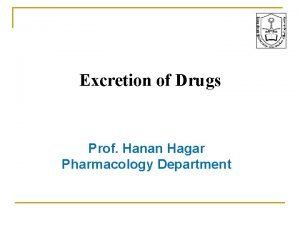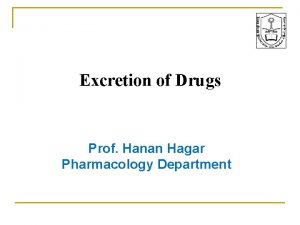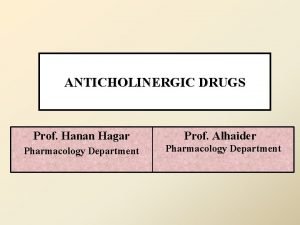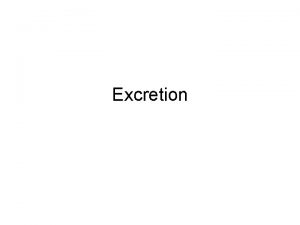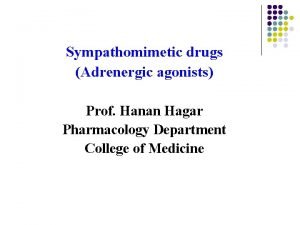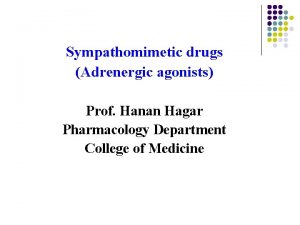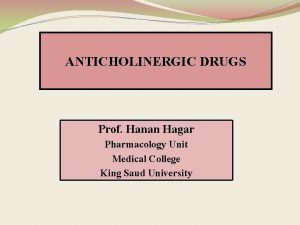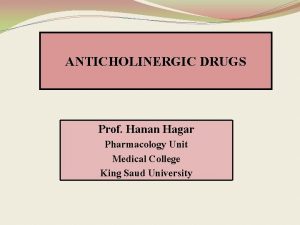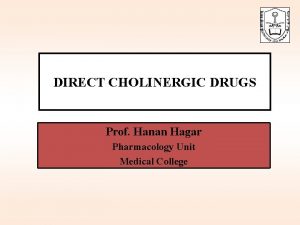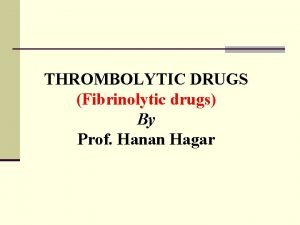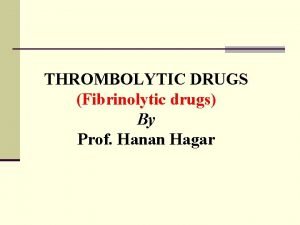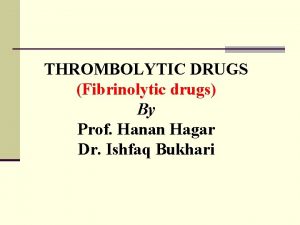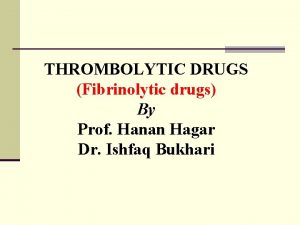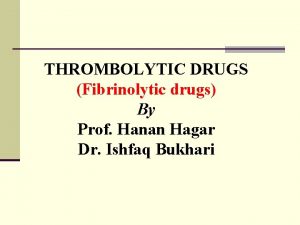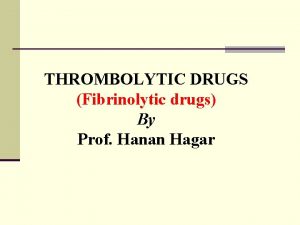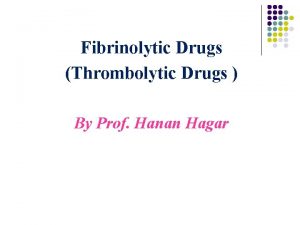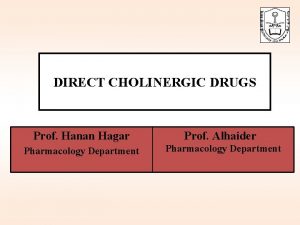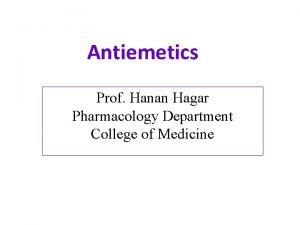Renal Excretion of Drugs Prof Hanan Hagar Pharmacology




































![Renal clearance: CLr (ml/min) = Excretion rate [Cu. Vu ] Plasma concentration [Cp Renal clearance: CLr (ml/min) = Excretion rate [Cu. Vu ] Plasma concentration [Cp](https://slidetodoc.com/presentation_image/27d0dd509acdf6f096b1733c8928fe9c/image-37.jpg)














- Slides: 51

Renal Excretion of Drugs Prof. Hanan Hagar Pharmacology unit

Excretion of Drugs By the end of this lecture, students should be able to n n n Identify main and minor routes of Excretion including renal elimination and biliary excretion Describe its consequences on duration of drugs. Identify the different factors controlling renal excretion of drugs. Know the meaning of urinary ion trapping. Know how we can prescribe drugs in patients with renal impairment.

Routes of Excretion q Major routes of excretion q q q Renal excretion. Biliary excretion. Minor routes of excretion q q Pulmonary excretion. Salivary excretion. Mammary excretion via milk. Skin / Dermal excretion via sweat.

Renal Excretion Structure of kidney The structural unit of kidney is NEPHRON That consists of : q Glomerulus q Proximal convoluted tubules q Henle’s loop (Ascending –Descending) q Distal convoluted tubules q Collecting ducts

Structure of kidney The structural unit of kidney is NEPHRON

Nephron

Renal excretion of drugs The most important organ for drug excretion is the kidney.

Normal kidney functions Regulation of electrolytes (aldosterone) Regulation of water balance (anti-diuretic hormone) Excretion of wastes & drug metabolites such as Urea Uric acid Creatinine

Renal excretion of drugs Urinary excretion of drugs occurs through three processes: q Glomerular filtration. q Active tubular secretion. q Passive or active tubular re-absorption

Glomerular filtration (GF) Blood is filtered across a semi-permeable membrane into the Bowman’s Capsule. Driving force for GF is hydrostatic pressure of blood flowing in capillaries. Filtrate contains water, glucose, amino acids, sodium bicarbonates, organic solutes and electrolytes (sodium, potassium, chloride). Blood cells, platelets, and plasma proteins are retained in the blood and not filtered.

Glomerular Filtration of drugs Most drugs are filtered through glomerulus. Glomerular filtration of drugs occurs to: q q Low molecular weight drugs q Water soluble drugs e. g. aminoglycosides, tubocurarine q q Free form of the drugs (not bound to plasma proteins). Drugs with low volume of distribution (Vd)

Glomerular Filtration Rate (GFR) n n n The amount of blood filtered by the glomeruli in a given time. Normal GFR = 125 ml/min. GFR is used as a marker or indicator for kidney function. GFR is determined by creatinine, inulin (inulin is easily filtered by kidney not reabsorbed). Creatinine clearance (Cr. Cl) is used as a marker instead of GFR.

Active Tubular Secretion of Drugs n occurs mainly in proximal tubules n It increases drug concentration in the filtrate. n Drugs undergo active secretion have excretion rate values greater than normal GFR. n Secretion of ionized drugs into the lumen e. g. penicillin G

Characters of active tubular secretion: n needs energy n transports drugs against concentration gradients between blood and filtrate. n requires carriers (transporters) n Saturable n Not specific (competition may happens).

Types of transporters n Transporters for organic acids e. g. Penicillin, aspirin, sulfonamides, probenecid. n Transporters for organic bases e. g. morphine, catecholamines, atropine, quinine. n n Probenecid can inhibits active tubular secretion of acidic drugs. Two drugs can compete for the same carrier: n Probenecid n & penicillin Probenecid & nitrofurantoin

Competitive active tubular secretion of drugs n Two structurally similar drugs having similar ionic charge and employing the same carriermediated process for excretion enter into competition. n A drug with greater rate of excretion will retard the excretion of other drug with which it competes. n The half life of both drugs is increased since the total sites for active secretion are limited.

Competitive active tubular secretion of drugs Beneficial competition: n Probenecid & penicillin G n Both require the same carrier for renal excretion. n Probenecid competes with or retards renal tubular secretion of penicillin G and thus less amount of penicillin G will be excreted → prolonged duration of action of penicillin G & increase in its antibacterial action.

Competitive active tubular secretion of drugs Harmful competition: n Probenecid & nitrofurantoin n Probenecid inhibits renal tubular secretion of nitrofurantoin thus decreases its efficacy in urinary tract infections (UTIs).

Tubular Re-absorption of Drugs n After glomerular filtration, drugs may be reabsorbed back from tubular lumen into systemic blood circulation. n It takes place along all the renal tubules. n Re-absorption increases half life of a drug. n Re-absorption may be passive or active.

Passive Tubular re-absorption of drugs n In distal convoluted tubules & collecting ducts. n Only lipid soluble drugs (non-ionized) undergo passive tubular re-absorption from tubular lumen back into blood (not excreted in the urine, urinary excretion will be low). n Ionized drugs (water soluble) are poorly reabsorbed, excreted easily in the urine, and urinary excretion will be high.

Polar drug= water soluble Non polar drug = lipid soluble

Active Tubular re-absorption of drugs n It occurs with endogenous substances or nutrients that the body needs to conserve. e. g. glucose, electrolytes, amino acids, uric acid, vitamins. n Probenecid inhibits active tubular re-absorption of uric acid. So, It increases excretion of uric acid in urine. n Probenecid acts as a uricosuric agent in the treatment of gout.

Factors affecting renal excretion of drugs ØBlood flow to the kidney ØPhysiochemical properties of drugs n Molecular weight n Lipid solubility n Degree of ionization n Volume of distribution n Binding character ØBiological factor e. g. age Ø Disease states ØUrine p. H

Factors affecting renal excretion of drugs 1) Renal blood flow: n Adequate renal function depends upon renal blood flow. n Decline in renal blood flow can decrease excretion of drugs. n NSAIDS e. g. aspirin and ibuprofen inhibit the production of prostaglandins and therefore reduces renal perfusion and GFR.

Factors affecting renal excretion of drugs 2) Molecular weight of the drug: Larger MW drugs are difficult to be excreted than smaller MW especially by glomerular filtration. 3) Lipid solubility of drugs: Ø Urinary excretion is inversely related to lipophilicity. Ø Increased lipid solubility increases volume of distribution of drug (Vd) and decreases renal excretion.

Factors affecting renal excretion of drugs 4) Degree of ionization of drugs: Ø Increased ionization of drug increases its water solubility and thus enhances its renal excretion. Ø Polar or water soluble drugs are easily filtered e. g aminoglycosides, tubocurarine.

Factors affecting renal excretion of drugs 4) Volume of distribution (vd): Ø Renal clearance is inversely related to volume of distribution of drugs (Vd). Ø Drugs with large Vd are poorly excreted in urine. Ø Drugs restricted to blood (low vd) have higher renal excretion rates.

Factors affecting renal excretion of drugs 5) Binding characteristics of drugs Ø Drugs that are bound to plasma proteins behave as macromolecules and cannot be filtered through glomerulus. Ø Only unbound form of drug (free form) appears in glomerular filtrate. Ø Protein bound drugs have long half lives.

Factors affecting renal excretion of drugs 6) Biological factor: Ø Age can affect renal clearance. Ø Renal clearance is reduced in neonates and elderly due to pharmacokinetic changes. Ø Dose reduction is advisable otherwise toxicity may occur.

Diseases states Impairs the elimination of drugs thus may increase half-life (t ½ ) of drugs. This may occur due to Reduced renal blood flow n Congestive heart failure. n Hemorrhage n Cardiogenic shock q Decreased renal excretion : n Renal disease (e. g. glomerulonephritis). q

Renal excretion of drugs and p. H of urine n Normal urine p. H is 5. 3 (Slightly acidic). n Urine p. H varies from 4. 5 to 8 depending upon the diet e. g. meat decreases urinary p. H (more acidic urine) and carbohydrates rich food may increase urinary p. H.

Renal excretion of drugs and p. H of urine n Most drugs are weak acids or weak bases n Normal urine (p. H 5. 3 ) slightly acidic and favors excretion of basic drugs. n Most of acidic drugs will be reabsorbed back into body. n Changing the p. H of urine can inhibit or enhance the passive tubular re-absorption of drugs.

n n n Urinary p. H trapping (Ion trapping) It is used to enhance renal clearance of drugs during toxicity. Urine acidification: by ammonium chloride (NH 4 Cl) increases excretion of basic drugs (amphetamine, gentamycin). Urine alkalization: by sodium bicarbonate Na. HCO 3 increases excretion of acidic drugs (aspirin).

Ion trapping Consider a barbiturate (weak acidic drug) overdose. Urine Blood p. H 5. 3 p. H 7. 4 More non-ionized portion weak acid drug + Less Ionized portion urine Most of acidic drug will be reabsorbed back into body.

Ion trapping In presence of sodium bicarbonate, urine is alkaline and more excretion of acidic drug into urine Urine Blood p. H 8. 0 p. H 7. 4 Less Non-ionized weak acid drug + More Ionized Urine Most of acidic drug will be eliminated into alkaline urine.

Creatinine clearance and drugs §excretion Creatinine clearance rate (Cr. Cl) is the unit volume (ml) of plasma cleared by the kidney per unit time (min). Ø Creatinine clearance (Cr. Cl) is used to estimate glomerular filtration rate (GFR) because creatinine is produced from muscle and freely filtered (low MW, water soluble, and is not protein bound).
![Renal clearance CLr mlmin Excretion rate Cu Vu Plasma concentration Cp Renal clearance: CLr (ml/min) = Excretion rate [Cu. Vu ] Plasma concentration [Cp](https://slidetodoc.com/presentation_image/27d0dd509acdf6f096b1733c8928fe9c/image-37.jpg)
Renal clearance: CLr (ml/min) = Excretion rate [Cu. Vu ] Plasma concentration [Cp ] CLr : renal clearance Cu : drug concentration in the urine Vu : volume of urine in 24 hours Cp: drug concentration in the blood

Estimation of Creatinine Clearance The Cockcroft-Gault equation for estimation of creatinine clearance Female: Cr. Cl = 0. 85 (140 − age) X body weight serum creatinine × 72 Male: Cr. Cl = (140 − age) X body weight serum creatinine × 72

Renal clearance of drugs: § If renal clearance is impaired, this may increase t ½ of drugs and may result into drug toxicity. § Drug renal clearance is especially important for some drugs which are: § Mainly excreted by the kidney § Have narrow therapeutic index (e. g. lithium, digoxin, warfarin).

Drugs excreted mainly by the kidney include: Antibiotics: Penicillins, cephalosporins Aminoglycosides (gentamycin) Sulfonamides NSAIDs e. g. aspirin Lithium Digoxin Immunosuppressants (cyclosporine) Anticancer drugs (cisplatin) Be careful upon prescribing those drugs in: Renal failure patients – Elderly patients

Creatinine clearance and drugs excretion So what should we do in renal impairment? q Drugs that are primarily excreted by the kidney need dose adjustment when creatinine clearance is below 60 ml/min. q Minor dose adjustment if Cr. Cl = 30 -60 m. L/min. q Major dose adjustment if Cr. Cl < 15 m. L/min. q Monitor blood levels of drugs (therapeutic monitoring). drug

When dose reduction is not required in renal impairment ? Ø Few drugs e. g. ceftriaxone, doxycycline that are excreted mainly into feces (biliary excretion) doesn’t need dose adjustment in renal impairment.

Orders of elimination n For first-order drug elimination, a constant percentage is lost per unit time. n Most drugs follow the first order kinetic of excretion e. g. pencillin, aminogylcosides , quinolones ect. n In first order kinetic: the rate of excretion increased with increased in concentration of drug in plasma (constant percentage is eliminated per unit time).

n If a drug with a 2 -hour half life is given with an initial dose of 8 mcg/ml, assuming first-order kinetics, how much drug will be left at 6 hours? a) 8 mcg/ml b) 4 mcg/ml c) 2 mcg/ml d) 1 mcg/ml 50% is lost every 2 h 2 h : 8 mg 2 h : 4 mg 2 h : 2 mg 4 mg 2 mg 1 mg

Orders of elimination n For zero-order drug elimination, a constant amount is lost per unit time. n E. g. Alcohol, phenytoin, aspirin n In zero order the rate of excretion is independent of the concentration of drugs in the plasma (constant amount is eliminated per unit time).


n n Risk Factors for NSAIDs-Associated Acute Renal Failure Prostagalndins (PGs) have major role in the preservation of renal function when pathologic states compromise physiologic kidney processes. PGI 2 and PGE 2 antagonize the local effects of circulating angiotensin II, endothelin, vasopressin, and catecholamines that reduce renal circulation. Prostaglandins preserve GFR by antagonizing arteriolar vasoconstriction. A significant reduction in GFR can occur following administration of an NSAID to a patient with any underlying disease states (NSAIDs inhibit production of PGs)

n n Risk Factors for NSAIDs-Associated Acute Renal Failure Prostagalndins (PGs) have major role in the preservation of renal function when pathologic states compromise physiologic kidney processes. PGI 2 and PGE 2 antagonize the local effects of circulating angiotensin II, endothelin, vasopressin, and catecholamines that reduce renal circulation. Prostaglandins preserve GFR by antagonizing arteriolar vasoconstriction. A significant reduction in GFR can occur following administration of an NSAID to a patient with any underlying disease states (NSAIDs inhibit production of PGs)

Summary n n n Polar drugs are readily excreted and poorly reabsorbed. Lipid soluble drugs are reabsorbed back and excretion will be low Acidic drugs are best excreted in alkaline urine (sodium bicarbonate). Basic drugs are best excreted in acidic urine (ammonium chloride). Inulin and creatinine are used to assess renal function. Competition for active secretion prolongs half life of some drugs e. g penicillin and probenicid.

Summary n Protein binding of drugs inhibits renal excretion of drugs except those that are actively secreted. n NSAIDS e. g aspirin and ibuprofen inhbits the production of PGs and thefore reduces renal perfusion and GFR. n Irrespective of the mechanism of excretion renal of drugs , decreased renal blood flow decrease excretion of drugs.

Questions? E-mail: hananhhagar@yahoo. com
 Ira pré renal renal e pós renal
Ira pré renal renal e pós renal Sindrome nefrótica
Sindrome nefrótica Rate of elimination of drug
Rate of elimination of drug Pharmacology of drugs acting on respiratory system
Pharmacology of drugs acting on respiratory system Adrenal drugs pharmacology
Adrenal drugs pharmacology Renal corpuscle
Renal corpuscle Shiva china
Shiva china A tirinha de hagar estabelece uma interessante contraponto
A tirinha de hagar estabelece uma interessante contraponto Hagar hamed rua
Hagar hamed rua Phillip hagar smith
Phillip hagar smith Drug metabolism definition
Drug metabolism definition Stone angel chapter wise summary
Stone angel chapter wise summary Glucouronide
Glucouronide Hanan lutfiyya
Hanan lutfiyya Hanan habib
Hanan habib Tim vidas
Tim vidas Primary tuberculosis
Primary tuberculosis Bun/creatinine ratio low
Bun/creatinine ratio low Excretion
Excretion Hagfish excretory system
Hagfish excretory system Nicotine excretion
Nicotine excretion Chapter 37 respiration circulation and excretion
Chapter 37 respiration circulation and excretion Egestion vs excretion
Egestion vs excretion Respiration and excretion
Respiration and excretion Porifera features
Porifera features Types of excretion
Types of excretion Diasylate
Diasylate Digestion and excretion lesson 3
Digestion and excretion lesson 3 Excretion
Excretion What is the function of glomerulus class 10
What is the function of glomerulus class 10 Water-soluble vitamins
Water-soluble vitamins Advantages of iv route of drug administration
Advantages of iv route of drug administration Malpighian tubules
Malpighian tubules Fena formula
Fena formula Porifera excretion
Porifera excretion Qqbreak
Qqbreak Excretion
Excretion What is excretion
What is excretion Metabolic waste
Metabolic waste What is excretion
What is excretion Pedicel
Pedicel Plant hormone
Plant hormone Excretory system
Excretory system What is excretion
What is excretion Porifera excretion
Porifera excretion Excretion
Excretion Vitamin e excretion
Vitamin e excretion Seeds travel
Seeds travel What is excretion
What is excretion Annual review of pharmacology and toxicology
Annual review of pharmacology and toxicology Clinical pharmacology
Clinical pharmacology Rationale meaning in pharmacology
Rationale meaning in pharmacology






